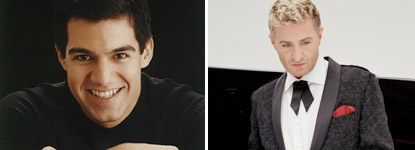The relatively young (he’s 43) Peruvian conductor of the Ft. Worth Symphony Orchestra, Miguel Harth-Bedoya, returned to LA (where he was assistant and then associate conductor from 1998-2004) on Saturday, Jan. 7, to conduct an LA Phil, without many of its principals, in three works, the Hussite Overture by Dvorák, the Piano Concerto No. 2 in A major by Lizst (commemorating the composer’s 200th birthday) with Jean-Yves Thibaudet as soloist, and the Symphony No. 3 in C minor (“Organ”) by Saint-Saëns.
On the surface, the three works selected by Harth-Bedoya don’t seem to have much in common except that they were all composed within a 20-year period toward the end of the 19th century and each in its own way represents the pinnacle of the Romantic period. However, whether it was his intent or not, these particular works share some subtler commonalities. First, each consists of numerous fluctuations in tempo, which Harth-Bedoya wasn’t shy about exposing. And second, each juxtaposes moments of quiet tenderness with moments of fierce energy.
The program began with Dvorák’s Hussite Overture, one of his early pieces in this genre and one of the most interesting, though not as refined as some of the later overtures. We should thank Harth-Bedoya for introducing us to such an interesting piece, which is pure Dvorák with all of its Czech melodies and rhythms. Dvorák’s Carnival Overture is frequently played, as it will be this season, but Dvorák wrote many exquisite overtures that deserve to be heard in the concert hall more often.
Reminding one a little of our own young South American conductor (although I prefer Gustavo Dudamel’s movements), Harth-Bedoya conducted the Dvorák and the Saint-Saëns scoreless and all three pieces with an energy and zeal that made the audience want to go along for the ride, and a wild ride it was.
The French piano virtuoso Jean-Yves Thibaudet didn’t do anything to slow things down in the Lizst, his fingers dancing across the keyboard and appearing to barely touch it. Both conductor and soloist were in the same groove and gave a wonderful performance of a piece that, because of its fluctuating rhythms and dynamics presented in one continuous movement, seems disjointed at times. And principal cellist for the night, Ben Hong, produced a beautifully rich sound in his solo with Thibaudet.
The Saint-Saëns is a piece that needs to be heard in Disney Hall with its magnificent organ. And Harth-Bedoya milked it for all it is worth — and it is worth a lot. Even though the organ part is not particularly demanding, Saint-Saëns, an organist himself, perfectly incorporated it into the fabric of the symphonic form. Principal keyboardist, Joanne Pearce Martin, was flawless in her playing, and Harth-Bedoya had her play it loudly so that it shook the rafters of Disney Hall.
Harth-Bedoya is also like Dudamel in his humbleness. He never ascended the podium to take his bows. Rather, he stood with and applauded the well-deserving orchestra. And, like Dudamel, he let Jean-Yves Thibaudet take the spotlight after the Lizst, even though Harth-Bedoya provided excellent accompaniment.
The concert repeats Sunday, Jan. 8, at 2 p.m. For more information, go to www.laphil.com.






